HP Z27q Monitor Review: Aiming For More Pixels
by Brett Howse on December 22, 2015 8:00 AM ESTAdobeRGB Calibration
AdobeRGB tests are done with the same workflow as sRGB, but with the target gamut set to AdobeRGB. As with the sRGB, precalibration results are done for 200 nits, and then calibrated results are done for 200 and 80 nits.
Grayscale
Set to AdobeRGB, the pre-calibration results are quite a bit improved over the sRGB values. They are so good that there is actually little reason to calibrate this display if you are using it for AdobeRGB. The average error rate on grayscale is only 1.08, and the gamma curve is almost perfect. The white point is very close to correct as well.
Saturation
Saturations are very good again, with an average error of just 0.5. This is a great result for an uncalibrated display, and you can see that it easily covers the much wider gamut of AdobeRGB here.
GMB
I feel like a broken record a bit, but the pre-calibration results for GMB are fantastic, with an average error of just 0.462. HP has done a fantastic job on the AdobeRGB LUT for this display.
200 cd/m2 Calibrated
Since the pre-calibration measurements were so good, there would be very little if any need to calibrate this display, but for completeness that has been done.
Grayscale
Although the couple of spikes for grayscale have been corrected, the overall result is actually slightly worse than out of the box. The gamma jumps up, and the white point is off. The results were better before, so if I was using this I would throw this out and leave it at stock.
Saturation
With the white point slightly moved, the overall error rate has actually gone up. It’s still excellent, but not as excellent as before.
GMB
The final test also has a higher score, which at 0.67 is still excellent, but the calibration did nothing to help this display on AdobeRGB gamut. Let’s see how it does at 80 nits.
80 cd/m2 Calibrated
Setting the display to 80 nits, it was then calibrated again.
Grayscale
Overall the result is very good again, although the gamma is not as flat as it was before calibration. The white point and average error rate are both very good though.
Saturation
Much like at 200 nits, the pre-calibration measurements are actually better again, but the end result even with the slightly worse scores is still a very accurate representation of the AdobeRGB color space.
GMB
A result of 0.96 is very good, and the Z27q pretty much had no issues with any of the colors in our Gretag Macbeth test.
Relative Color Comparator - Displayed color on bottom, correct color on top
The results from AdobeRGB are even more impressive than the sRGB space. The Z27q can easily hit pretty much 100% of this target gamut, and the built in LUT is incredibly accurate when targeting AdobeRGB. This is one of the rare times were calibration pretty much did nothing.


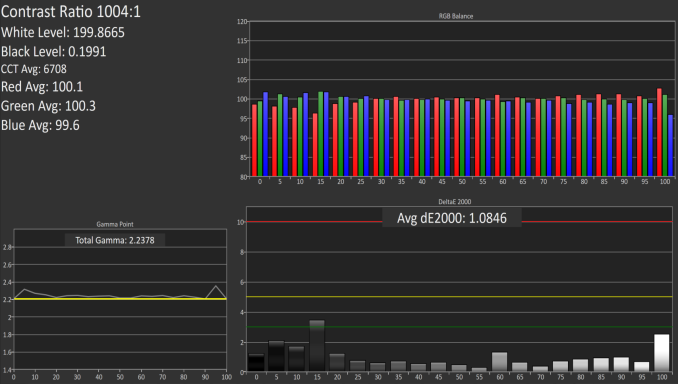
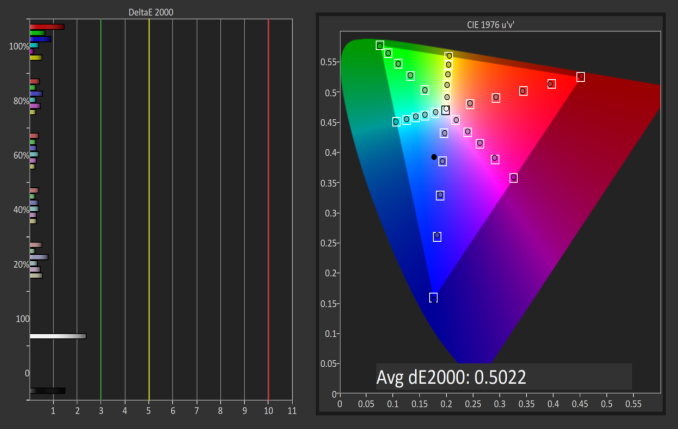
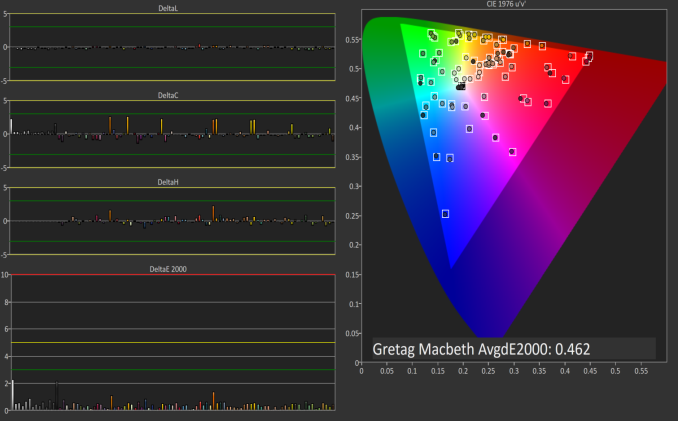
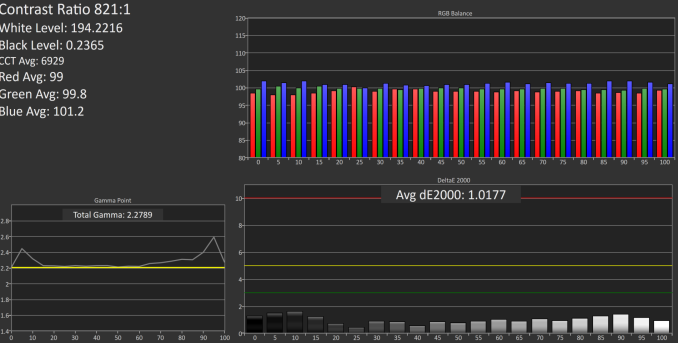
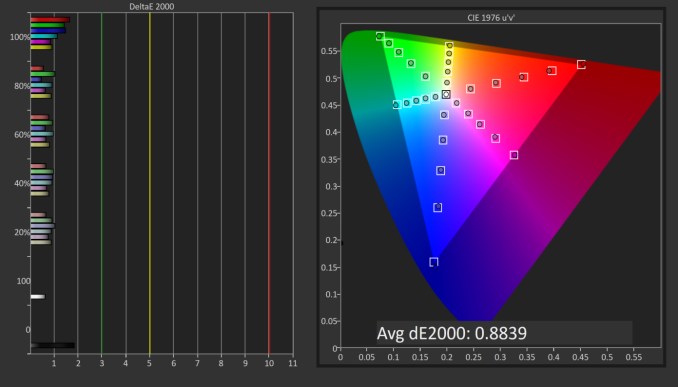

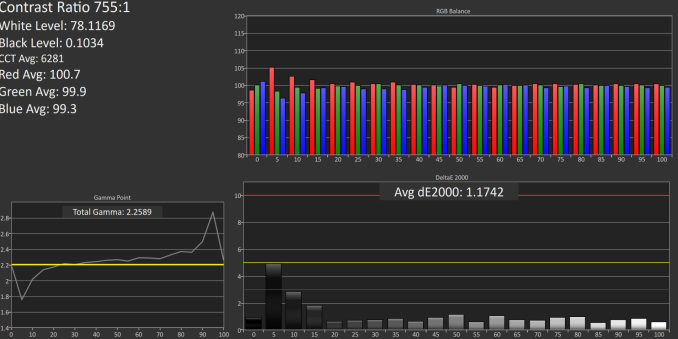











92 Comments
View All Comments
Murloc - Tuesday, December 22, 2015 - link
I think they are not centralized in one HQ so it isn't enough to have "someone" who's good at photography.brucek2 - Thursday, December 24, 2015 - link
I agree -- the cover photo is so unflattering that it is easily the strongest impression I am taking away from this review, and what I will remember most / the longest. Despite all the text that follows what this article has communicated most forcefully is that "this monitor is a piece of junk." It appears it arrived warped. Unless this is actually the case it is very unfair to the manufacturer.nathanddrews - Tuesday, December 22, 2015 - link
You should try out the new MadVR build with HDR LUT as part of your monitor reviews. 300 nits is a bit better than the standard 150/200nits of other monitors.CaedenV - Tuesday, December 22, 2015 - link
So are those extra 1000 pixels of height enough to cram in all of your UI in Adobe so you can edit 4K content while looking at native resolution? Heck at 4K 27" can you even see individual pixels when sitting a normal distance away from the monitor? I am sure that you can't with 5K! That's just ridiculous pixel density. I'm looking at moving to 4K myself and with my own measurements and distance from the screen I am looking at a 48" TV to get slightly higher pixel density without having the scaling issues of Windows... can't imaging how bad scaling would be on such a high res display!MrSpadge - Tuesday, December 22, 2015 - link
On my 25" DELL with 2560x1440 I can't see individual pixels, whereas at work my 24" 1920x1200 looks a bit gross in comparison, because verything is so large. From my point of view my DELL has pretty much the perfect resolution to (mostly) work without scaling.DanNeely - Tuesday, December 22, 2015 - link
I can't see the pixels on my 30" 2560x1600 monitor; but the text the 3200x1800 screen of my XPS13 is noticeably sharper due to the higher DPI. Next year's big tech buy for me will probably be a 31.5" 5k monitor.zeeBomb - Tuesday, December 22, 2015 - link
Damn...a monitor review? By Brett? Is this a fake review!?petteyg359 - Tuesday, December 22, 2015 - link
Why must they keep pushing huge screens? Give me 4k and 5k in 24" or less so I can actually fit two of them on my desk.ImSpartacus - Tuesday, December 22, 2015 - link
There are 24" 4k monitors, but you wouldn't want 5k at that size. You'd have to use non-integer scaling to make stuff readable.Murloc - Tuesday, December 22, 2015 - link
what's the point? Just use windows management software if you can't deal with one big screen.